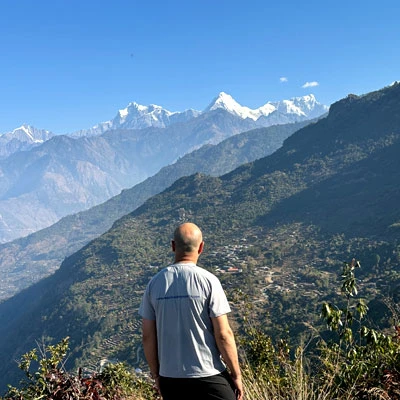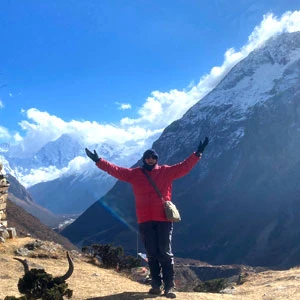Food Along The Gokyo Valley Trek: What To Expect
Food along the trail is primarily served in local tea houses that provide both meals and accommodation. They typically feature a communal dining hall with a central stove or fireplace, where you will gather in the evening to warm up, share stories, and enjoy home-cooked meals.
As you sit in the hall, they will hand you the printed menu, and all orders (breakfast, lunch, and dinner) are taken in advance to help the staff plan meals efficiently. While the variety of food may seem limited compared to city restaurants, the menus offer a surprisingly decent range of both traditional Nepali dishes and familiar Western comfort foods.
That said, you get to experience an authentic food experience as you adjust to the local cuisine. A fun fact: the higher you go into the Himalayas, fresh vegetables can become limited due to transportation challenges as most supplies are carried by porters, yaks, or helicopters.
Furthermore, fresh meat is generally not available and is best to avoid due to hygiene concerns. Likewise, in many remote Himalayan areas, there is limited awareness and practice regarding proper cooking oil usage. At times, they may reuse the same oil to fry foods until it’s fully consumed. Hence, NTE does not recommend you to try fried foods.
Common Meals Along The Trails Of Gokyo Valley
Food is a central part of the trekking experience in the Gokyo Valley. While the menus may be simple, they offer a balance of energy-rich, warm meals suited for high-altitude trekking. Most tea houses along the route follow a standardized menu format. Here is what you can expect to eat throughout your journey.
Breakfast
For breakfast, tea houses typically offer a mix of local and Western-style options. Here, Tibetan bread is a popular choice and is often served with jam, honey, or peanut butter. Similarly, pancakes are another common item that is available in plain, apple, banana, or chocolate variations.
If you are looking for something warm and easily digestible, you will also get porridge. Additionally, they also have oatmeal, cornflakes, or traditional Tsampa porridge made from roasted barley flour. Likewise, you can also get eggs in many styles: boiled, fried, scrambled, or as an omelet with optional cheese and vegetables.
Lunch And Dinner
Lunch and dinner menus tend to overlap on the trek. These meals are warm, satisfying, and often customizable depending on your preferences.
The most famous meal among trekkers is Dal Bhat, a traditional Nepali set meal that includes rice, lentil soup, seasonal vegetables, and a small serving of pickle. The best part? You will get unlimited refills of rice and lentils.
On top of it, you will also see a variety of fried rice and fried noodles, with vegetarian, egg, or chicken options. You will also find Sherpa stew, momo, thukpa, and chowmein. If you are craving a Western touch, you can also get items such as macaroni, spaghetti, and other pasta dishes.
Soup And Snacks
If you are craving something warm, then you must try garlic soup. While it keeps you warm, it also helps prevent altitude sickness. Other choices include vegetable soup, noodle soup, and even instant ramen-style broths. They are perfect as a starter or a light meal when you are not too hungry.
For snacks, NTE recommends you carry them from the city itself. While you will find store-bought treats like chocolate bars, nuts, almonds, muesli bars, biscuits, and other packaged snacks like popcorn and french fries, you will have to pay higher prices.
Hot Drinks
While in the Himalayas, you should try giving yourself a break, sip on a tea or coffee while enjoying the view. One of the best drinks is masala tea. Similarly, you can also try ginger tea or ginger lemon honey tea. This particular drink is best for your sore throat.
Now, if you prefer something milder, milk tea or plain black tea is always available. You can also try coffee or hot chocolate.
For a truly local experience, you must try yak butter tea, also known as Su Cha. It’s made from tea, salt, and butter (often from yaks).
Hydration And Safe Drinking Water
At high altitudes, your body loses fluids faster through increased respiration, dry air, and physical exertion. Over time, dehydration becomes a major contributor to altitude sickness, fatigue, and headaches. Hence, to keep your body functioning optimally, you should aim to drink at least 3 to 4 liters of water daily, even if you don't feel particularly thirsty.
Along the trails, tea houses do provide boiling water, and they usually charge NRs 100 to 300 per liter. Here, you can also buy bottled mineral water; however, the price of the bottles goes higher as you trek higher.
Now, if you want to save costs, it is best to carry your own water bottle along with a water purification tablet or filter to drink water directly from the source.
Special Dietary Needs And Restrictions
Since Nepali tea houses primarily serve vegetarian dishes in the Himalayas, the trek is quite accommodating for vegetarians. In fact, many locals adopt a vegetarian diet at higher altitudes for both religious and logistical reasons.
However, it is important to communicate your dietary needs effectively. If you have severe allergies or strict dietary needs, you need to convey them clearly to the locals via your guide. Now, if your dietary needs are highly specific, it’s smart to carry your own snacks and supplements.
Having said that, you can also manage your specific dietary needs with a bit of communication, either through your guide or directly with the kitchen staff. While dishes like porridge, tea, and bread are often prepared with butter, milk, or ghee, you can request dairy-free versions, and they will accommodate when informed in advance.
Moving on, vegetarians and vegans can also manage their food preferences, as many traditional meals are plant-based or can be easily adjusted. If you communicate your needs clearly, you can enjoy both the trek and the food without compromising your dietary preferences.
Foods To Avoid At High Altitudes During the Trek
When trekking to high altitudes like the Gokyo Valley, you need to be mindful of what you eat. One of the most important food items to avoid is meat, especially as you gain elevation. While meat may be available at tea houses, it’s rarely fresh above Namche Bazaar due to the lack of refrigeration and the challenges of transporting goods to remote regions.
Additionally, alcohol is another item to steer clear of during the trek. While a cold beer or a glass of local raksi might sound tempting after a long day of hiking, alcohol significantly hampers the body’s ability to acclimate. It dehydrates you, impairs your sleep quality, and reduces oxygen absorption. Even moderate consumption can trigger symptoms of Acute Mountain Sickness (AMS).
Likewise, caffeinated energy drinks such as Red Bull or Monster can be harmful as they speed up dehydration. They can also cause irregular heartbeats or spikes in blood pressure, further straining your body under altitude stress.
Lastly, you must avoid raw or uncooked food, including salads, unpeeled fruits, and undercooked meats. The water used to rinse raw vegetables may not be purified, making it a common source of stomach infections. Additionally, you must also avoid fried meals as they commonly reuse the oil which can be a health concern.
Cost Of Food On The Trail
On average, you will spend about USD 25 to 35 per day on food and drinks on the trail. This estimate allows for three filling meals and several hot beverages.
A basic breakfast will cost you anywhere between USD 5 to 10. Lunch options typically range from USD 10 to 15, while dinner costs can mirror lunch prices or go slightly higher. Similarly, hot beverages usually cost USD 2 to 4, depending on the altitude and the establishment.
Altogether, the prices increase as you ascend because of the sheer logistics involved in delivering supplies to remote mountain villages.
Nourishment Tips Along The Trail
- Eat three solid meals and 2 to 3 small snacks each day, combining complex carbohydrates with protein.
- Carry high-energy snacks like nuts, granola or protein bars, trail mix, and chocolate, and dried fruits.
- Try garlic soup or ginger-lemon tea to aid digestion, improve circulation, and help ward off mild altitude effects.
- Opt for light, nourishing dinners.
- Drink at least 3 to 4 liters of water every day.
- Avoid menu fatigue by alternating between Nepali and Western dishes.
- You can ask for a bit of ghee, butter, or cheese on your rice or noodles for extra calories.
- Start each morning with hot tea or coffee, and sip warm beverages throughout the day to help maintain core temperature.
Conclusion
At high altitudes, your body works harder with every step, and staying energized through balanced, regular meals is essential. The meals along the trail satisfies your hunger and also support your health, mood, and stamina. Hence, you should make smart food choices by avoiding risky items like stale meat or unfiltered water.
As you trek through remote Himalayan villages and scenic ridgelines, you should keep an open palate for the local cuisine. You should be curious about new flavors like tsampa porridge or yak cheese, and savor them as part of the adventure.
FAQs
What kind of food is available on the Gokyo Valley Trek?
You will find a mix of Nepali (like dal bhat), Tibetan, and basic Western dishes like pasta, pancakes, and fried rice.
Is vegetarian food easily available on the trek?
Yes, most tea houses offer plenty of vegetarian options, and many trekkers choose to eat vegetarian at high altitudes.
Can I eat meat on the Gokyo Valley Trek?
It’s best to avoid meat above Namche Bazaar, as it’s not fresh and can cause food poisoning.
How much should I budget for food per day on the trek?
You should expect to spend around USD 25 to 35 per day on food and drinks.
Can I get vegan or gluten-free food on the trail?
The vegan or gluten-free options are limited, but you can manage with dal bhat, vegetables, rice, and requesting simple customizations.
Should I bring my own snacks?
Yes, you must carry high-energy snacks like protein bars, nuts, and chocolates for in-between meals.
Can I drink tap water on the Gokyo trek?
No, always drink boiled, filtered, or treated water to avoid waterborne illnesses.
Are alcoholic drinks available on the trek?
Yes, but you should avoid alcohol during the trek as it hampers acclimatization.
What is the most recommended meal on the trek?
You must try Dal Bhat as it is nutritious, filling, and comes with unlimited refills.







